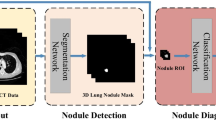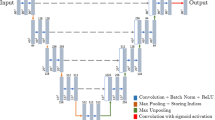Abstract
Segmentation algorithm based on deep learning has become the main method of pulmonary nodules segmentation; nevertheless, the accuracy and lightweight of most such models are difficult to coexist. In order to accurately segment lung nodules in computed tomography images and make the model lightweight, this paper proposes a lightweight segmentation network called SKV-Net, able to achieve good performance. The overall design of the network uses the original V-Net structure and introduces a selective convolution kernel with soft attention in selective kernel networks to extract multi-scale feature information. Adopting a suitable grouped convolution can effectively reduce the number of parameters in the model while maintaining good segmentation performance. Experimental results indicate that the average segmentation accuracy of SKV-Net is 1.3% higher than that of V-Net, and the number of parameters is only 42% those of V-Net. In this paper, the Luna16 public dataset of pulmonary nodules is used to test and evaluate the performance of various improved models. The results suggest that the SKV-Net is superior to other models, achieving good segmentation performance and fast operation speed. Moreover, the SKV-Net improves the segmentation of different types of pulmonary nodules. It has the advantages of high precision and lightweight structure, which further indicate that it has significant clinical application value in the segmentation task of pulmonary nodules.







Similar content being viewed by others
Data availability
The code described in this study is available from the first author upon reasonable request. Data supporting the results of this study will be provided by the first author upon reasonable request upon approval by the review Committee of the School of Physics and Electronic Information, Yan’an University.
References
Sherafatian, M., Arjmand, F.: Decision tree-based classifiers for lung cancer diagnosis and subtyping using TCGA miRNA expression data. Oncol. Lett. 18, 2125–2131 (2019)
Qinghua, Z., Yaguang, F., Ying, W., Youlin, Q., Guiqi, W., Yunchao, H., Xinyun, W., Ning, W., Guozhen, Z.: Chinese guidelines for classification, diagnosis and treatment of pulmonary nodules. Chin. J. Lung 19, 793–798 (2016)
Xiaoju, Z., Li, B., Faguang, J., Qun-ying, H., Jie, H., Chun-xue, B., Liang-an, C., Weimin, L.: Lung nodule diagnosis and treatment in China. Chin. J. Tuberc. Respir. 41, 763–771 (2018)
Armato, S.G., Giger, M.L., Moran, C.J., Blackburn, J.T., Doi, K., MacMahon, H.: Computerized detection of pulmonary nodules in CT scans. Radiology 209, 161–161 (1998)
Ying, W., Xinhe, X., Tong, J., Dazhe, Z.: Extraction of suspected pulmonary nodules from CT images based on multi-scale morphological filtering. J. Northeastern Univ. (Nat. Sci.) 3, 312–315 (2008)
Hui, L., Caiming, Z., Kai, D., Zhi-yuan, S.: J. Comput. Aided Des. Comput. Graph. 26, 1727–1736 (2014)
Yehang, C., Zhi, L., Bao, F., Xiangmeng, C., Wansheng, L.: Segmentation of pleural contact pulmonary nodules based on improved active contour model. Chin. J. Sci. Instrum. 40, 107–116 (2019)
Kostis, W.J., Reeves, A.P., Yankelevitz, D.F.: Threedimensional segmentation and growth-rate estimation of small pulmonary nodules in helical CT images. IEEE Trans. Med. Imaging 22, 1259–1274 (2003)
Kommrusch, S., Pouchet, L.N.: Synthetic lung nodule 3D image generation using autoencoders. Int. Joint Conf. Neural Netw. 10, 1–9 (2019)
Long, J., Shelhamer, E., Darrell, T.: Fully convolutional networks for semantic segmentation. IEEE Trans. Pattern Anal. Mach. Intell. 39, 640–651 (2015)
Korez, R., Likar, B., Pernus, F., Vrtovec, T.: Model-based segmentation of vertebral bodies from MR images with 3D CNNs. MICCAI 2016. In: Lecture Notes in Computer Science. vol. 9901 (2016).
Nguyen, R.D., Smyth, M.D., Zhu, L., Pao, L.P., Swisher, S.K., Kennady, E.H., Mitra, A., Patel, R.P., Lankford, J.E., Von Allmen, G., et al.: A comparison of machine learning classifiers for pediatric epilepsy using resting-state functional MRI latency data. Biomed. Rep. 15, 77 (2021)
Ronneberger, O., Fischer, P., Brox, T.: U-Net: convolutional networks for biomedical image segmentation. Med. Image Comput. Comput. Assist. Interv. (MICCAI) 9351, 234–241 (2015)
Feng, X., Bin, Z., Jinxiang, G., Libo, L.: Segmentation of nodules based on u-net. Softw. Guide 17, 161–164 (2018)
Wenjun, Z., Ming, C., Ying, Z., Mengyi, Z., Lihang, F.: A new method for segmentation of lung nodules based on Mobile-Unet network. J. Nanjing Univ. Technol. (Nat. Sci.) 09, 1–8 (2021)
Sihua, Z., Xingming, G., Yineng, Z.: Improved segmentation method of pulmonary nodules using u-net network. Comput. Eng. Appl. 56, 203–209 (2020)
Ozgun, C., Abdulkadir, A., Lienkamp, S.S.: 3D Net: learning dense volumetric segmentation from sparse annotation. Med. Image Comput. Comput. Assist. Interv. (MICCAI): 424–432, 2016.
Hui, Z., Pinle, Q.: U-net algorithm for pulmonary nodules detection based on multi-scale characteristic structure. Comput. Eng. Program 45, 254–261 (2019)
Minjie, H., Gang, W., Xingchen, L., Juncheng, J., Xinhao, Y.: Detection of pulmonary nodules based on attention mechanism. Comput. Eng. Des. 42, 83–88 (2021)
Gao, X., Xiaojun, B.: Detection of pulmonary nodules in low-dose CT images based on improved faster R-CNN. Appl. Res. Comput. 37, 404–406 (2020)
Bo, W., Xupeng, F., Lijun, L., Qingsong, H.: Detection of pulmonary nodules in CT images based on improved YOLO algorithm. Beijing Biomed. Eng. 39, 615–621 (2020)
Singadkar, G., Mahajan, A., Thakur, M., Talbar, S.: Deep deconvolutional residual network based automatic lung nodule segmentation. J. Digit. Imaging 33, 4 (2020)
Milletari, F., Navab, N., Ahmadi, S.A.: V-net: fully convolutional neural networks for volumetric medical image segmentation. In: Fourth International Conference on 3D Vision (3DV), IEEE, pp. 565–571 (2016).
Jintao, H., Dongwei, H., Boming, X., Pan, S., Miao, T.: MRI visualization system for human brain and hippocampus segmentation based on VNet neural network. Mechatronics 27, 24–31 (2021)
Sihua, Z., Meng-lu, W., Xingming, G., Yao, Z., Yineng, Z.: Research on segmentation of pulmonary nodules based on improved VNet. Chin. J. Sci. Instrum. 41, 206–215 (2020)
Yixin, C., Lei, C., Shu-guang, C., Jing-yang, G.J.: Beijing Univ. of Chem. Technol. (Nat. Sci.) 48: 86–95 (2017)
Li, X., Wang, W., Hu, X.: Selective Kernel networks. In: Conference on Computer Vision and Pattern Recognition (CVPR), IEEE, pp. 510–519 (2020).
He, K., Zhang, X., Ren, S.: Deep residual learning for image recognition. In: 2016 IEEE Conference on Computer Vision and Pattern Recognition (CVPR), pp. 770–778 (2016).
Armato, S.G., Roberts, R.Y., Mcnitt-Gray, M.F.: The lung image database consortium (LIDC) and image database resource initiative (IDRI): a completed reference database of lung nodules on CT scans. Acad. Radiol. 14, 1455–1463 (2007)
Howard, A., Sandler, M., Chen, B.: Searching for MobileNetV3. In: International Conference on Computer Vision (ICCV), pp. 1314–1324 (2019).
Dutande, P., Baid, U., Talbar, S.: LNCDS: A 2D–3D cascaded CNN approach for lung nodule classification, detection and segmentation. Biomed. Signal Process Control 67, 6 (2021)
Gpa, B., Vrr, A., Prb, C.: CoLe-CNN:Context-learning convolutional neural network with adaptive loss function for lung nodule segmentation. Comput. Methods Programs Biomed. 1, 198 (2021)
Szegedy, C., Ioffe, S., Vanhoucke, V.: Inception-v4, inception-ResNet and the impact of residual connections on learning. AAAI 31, 4278–4284 (2017)
Jinzhu, Y., Bo, W., Lanting, L., Peng, C., Osmar, Z.: MSDS-UNet: a multi-scale deeply supervised 3D U-Net for automatic segmentation of lung tumor in CT. Comput. Med. Image Grap. 10, 1–16 (2021)
Jie, H., Li, S., Gang, S., et al.: Squeeze-and-excitation networks. IEEE Trans. Pattern Anal. Mach. Intell. 42, 2011–2023 (2020)
Acknowledgements
Not applicable.
Funding
The current study was supported by the Scientific and Technology Innovation Team of Yan’an University (2017CXTD-01), the Graduate Teaching Reform Project of Yan’n University (YDYJG2019016) and the Special Research Project of Yan’an University (YCX2022078).
Author information
Authors and Affiliations
Contributions
Z-RW performed conceptualization. Z-RW and J-RM were involved in software. Z-RW and F-CZ were involved in data curation, methodology, writing—original draft preparation and funding acquisition. All authors have read and agreed to the published version of the manuscript.
Corresponding author
Ethics declarations
Conflict of interest
The authors declare that they have no competing interests.
Consent for publication
Not applicable.
Ethical approval
Not applicable.
Additional information
Publisher's Note
Springer Nature remains neutral with regard to jurisdictional claims in published maps and institutional affiliations.
Rights and permissions
Springer Nature or its licensor (e.g. a society or other partner) holds exclusive rights to this article under a publishing agreement with the author(s) or other rightsholder(s); author self-archiving of the accepted manuscript version of this article is solely governed by the terms of such publishing agreement and applicable law.
About this article
Cite this article
Wang, Z., Men, J. & Zhang, F. Improved V-Net lung nodule segmentation method based on selective kernel. SIViP 17, 1763–1774 (2023). https://doi.org/10.1007/s11760-022-02387-w
Received:
Revised:
Accepted:
Published:
Issue Date:
DOI: https://doi.org/10.1007/s11760-022-02387-w




